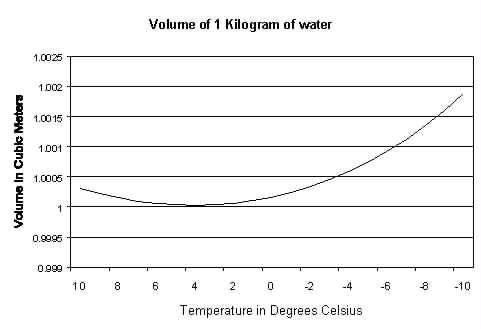
| MadSci Network: Physics |
The volume that a given weight of liquid, such as water, occupies changes as the temperature of the liquid changes. This is known as thermal expansion. Liquids are commonly used to measure temperature changes by measuring the height of liquid in a glass tube. As the temperature of the liquid increases, it will occupy more space, and move higher in the tube. This is possible because a liquid in a container has a flat surface. It will find its own level.
Water can be used in such thermometers if the temperature being measured is between +4 and +100 degrees celsius. The earliest Thermometers were glass tubes filled with water. Water boils at 100 degrees celsius and the water vapour (steam) will escape from the tube into the air. Most liquids decrease in volume or shrink as the temperature gets lower and increase in volume as the temperature increases. Below 4 degrees celsius the rate of change in the volume of water with changes in temperature starts to change. Below 4 degrees, water actually starts to increase in volume as the temperature gets lower. The variation in the thermal expansion of water near the freezing point is shown in the graph.

In the temperature range from +4 to 0 degrees the thermometer would not read correctly. Water freezes and becomes a solid at 0 degrees Celsius. Once the water becomes a solid it will no longer find its own level in the container. The water will then expand in all directions and the container will probably break. This is why pipes break in the winter when the water in them freezes.
Mercury was commonly used in thermometers. Mercury melts at -38.87 degrees celcius and boils at 356.58 degrees. Mercury is used less often today because of its toxicity in the environment. Mercury is bing replaced by other liquids.
For more information on temperature measurement check:
http://www.omega.com/pdf/temperature/Z/zsection.asp
Try the links in the MadSci Library for more information on Physics.